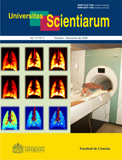Abstract
La resistencia desarrollada por el Plasmodium falciparum ante los fármacos tradicionales del tipo 4-amino-7-cloroquinolínicos ha llevado al diseño y síntesis de inhibidores duales, como los híbridos de la cloroquina. Además del farmacóforo típico en esta clase de antimaláricos, tales híbridos incorporan un espaciador metilénico como parte de un fragmento diamínico, cuyo propósito es la funcionalización del grupo amino terminal en sistemas heterocíclicos diversos con actividades biológicas reportadas. Esto con el fin de evitar la rápida eliminación de la molécula por parte del parásito, lo que se conoce como resistencia. Se discuten el diseño y síntesis de estos híbridos moleculares.
Palabras clave: Malaria, resistencia a la cloroquina, híbridos moleculares, funcionalización.
Abstract
Antimalarials: construction of molecular hybrids based on chloroquine. The resistance developed by Plasmodium falciparum against traditional 4-amino-7-chloro quinolinic drugs has lead to the design and synthesis of dual inhibitors such as chloroquine hybrids. Besides the usual pharmacophore in this type of antimalarials, such hybrids incorporate a methylenic spacer as part of a diaminic fragment whose purpose is the functionalization of the terminal amino group in various heterocyclic systems having reported biological activities. The prime goal is to avoid the molecule rapid elimination by the parasite, which is known as resistance. The design and synthesis of these molecular hybrids are discussed.
Key words: malaria, chloro quine resistance, molecular hybrids, functionalization
Resumo
Antimaláricos: Construção de híbridos moleculares da cloroquina. A resistência desenvolvida pelo Plasmodium falciparum frente aos fármacos tradicionais do tipo 4-amino-7-cloroquinolínicos tem levado ao desenho e síntese de inibidores duais, como os híbridos da cloroquina. Além do farmacóforo típico nesta classe de antimaláricos, tais híbridos incorporam um espaçador metilénico como parte de um fragmento diamínico, que tem por propósito a funcionalização do grupo amino terminal em sistemas heterocíclicos diversos com atividades biológicas reportadas. Isto com a finalidade de evitar a rápida eliminação da molécula por parte do parasito, o que se conhece como resistência. É discutido o desenho e sínteses destes híbridos moleculares.
Palavras chave: Malária, resistência à cloroquina, híbridos moleculares, funcionalização
Univ. Sci. is registered under a Creative Commons Attribution 4.0 International Public License. Thus, this work may be reproduced, distributed, and publicly shared in digital format, as long as the names of the authors and Pontificia Universidad Javeriana are acknowledged. Others are allowed to quote, adapt, transform, auto-archive, republish, and create based on this material, for any purpose (even commercial ones), provided the authorship is duly acknowledged, a link to the original work is provided, and it is specified if changes have been made. Pontificia Universidad Javeriana does not hold the rights of published works and the authors are solely responsible for the contents of their works; they keep the moral, intellectual, privacy, and publicity rights. Approving the intervention of the work (review, copy-editing, translation, layout) and the following outreach, are granted through an use license and not through an assignment of rights. This means the journal and Pontificia Universidad Javeriana cannot be held responsible for any ethical malpractice by the authors. As a consequence of the protection granted by the use license, the journal is not required to publish recantations or modify information already published, unless the errata stems from the editorial management process. Publishing contents in this journal does not generate royalties for contributors.



